Influence of Hot Deformation and Precipitates on the Recrystallization of Nb-V-Ti Free-Cutting Steel
Abstract
:1. Introduction
2. Materials and Methods
3. Results and Discussion
3.1. Equilibrium Phase Diagram
3.2. Flow Stress Behavior
3.3. Constitutive Relationship
3.4. Processing Map
3.5. Microstructure Observation
4. Conclusions
Author Contributions
Funding
Conflicts of Interest
References
- Naylor, D.J. Microalloyed Forging Steels. Mater. Sci. Forum 1998, 284, 83–94. [Google Scholar] [CrossRef]
- Felker, C.A.; Speer, J.G.; De Moor, E. Hot Strip Mill Processing Simulations on a Ti-Mo Microalloyed Steel using Hot Torsion Testing. Metals 2020, 10, 334. [Google Scholar] [CrossRef] [Green Version]
- Shao, X.; Wang, X.; Jiang, M. Effect of Heat Treatment Conditions on Shape Control of Large-sized Elongated MnS Inclusions in Resulfurized Free-cutting Steels. ISIJ Int. 2011, 51, 1995–2001. [Google Scholar] [CrossRef] [Green Version]
- Wang, F.; Guo, H.; Liu, W. Control of MnS Inclusions in High- and Low-Sulfur Steel by Tellurium Treatment. Materials 2019, 12, 1034. [Google Scholar] [CrossRef] [Green Version]
- Zhou, Q.; Li, Z.; Wei, Z.S. Microstructural features and precipitation behavior of Ti, Nb and V microalloyed steel during isothermal processing. J. Iron Steel Res. Int. 2019, 26, 102–111. [Google Scholar] [CrossRef]
- Hodgson, P.D.; Gibbs, R.K. A Mathematical Model to Predict the Mechanical Properties of Hot Rolled C-Mn and Microalloyed Steels. ISIJ Int. 1992, 32, 1329–1338. [Google Scholar] [CrossRef] [Green Version]
- Mirzadeh, H.; Cabrera, J.M.; Prado, J.M. Hot deformation behavior of a medium carbon microalloyed steel. Mater. Sci. Eng. A 2011, 528, 3876–3882. [Google Scholar] [CrossRef]
- Ding, R.; Guo, Z.X. Coupled quantitative simulation of microstructural evolution and plastic flow during dynamic recrystallization. Acta Mater. 2001, 49, 3163–3175. [Google Scholar] [CrossRef]
- Custers, J.F.H. On the relation between deformation and recrystallization texture of nickel-iron with cubic orientation. Physica 1947, 13, 97–116. [Google Scholar] [CrossRef]
- Yamagata, H.; Ohuchida, Y.; Saito, N. Nucleation of new grains during discontinuous dynamic recrystallization of 99.998 mass% Aluminium at 453 K. Scr. Mater. 2001, 45, 1055–1061. [Google Scholar] [CrossRef]
- Gourdet, S.; Montheillet, F. An experimental study of the recrystallization mechanism during hot deformation of aluminium. Mater. Sci. Eng. A 2000, 283, 274–288. [Google Scholar] [CrossRef]
- Gourdet, S.; Konopleva, E.V.; Mcqueen, H.J. Recrystallization during Hot Deformation of Aluminium. Mater. Sci. Forum 1996, 217, 441–446. [Google Scholar] [CrossRef]
- Feng, W.; Qin, F.; Long, H. Hot workability analysis and processing parameters optimisation for 20CrMnTiH steel by combining processing map with microstructure. Ironmak. Steelmak. 2018, 45, 317–324. [Google Scholar] [CrossRef]
- Wen, S.B.; Han, C.Y.; Zhang, B.; Liang, Y.F.; Ye, F.; Lin, J.P. Flow Behavior Characteristics and Processing Map of Fe-6.5wt. %Si Alloys during Hot Compression. Metals 2018, 8, 186. [Google Scholar] [CrossRef] [Green Version]
- Kim, Y.M.; Kim, S.K.; Kim, N.J. Simple method for tailoring the optimum microstructures of high-strength low-alloyed steels by the use of constitutive equation. Mater. Sci. Eng. A 2019, 743, 138–147. [Google Scholar] [CrossRef]
- Buken, H.; Sherstnev, P.; Kozeschnik, E. Simultaneous Precipitation and Recrystallization during Hot Deformation of Ti, Nb and V Microalloyed Steel. Mater. Sci. Forum 2016, 879, 2463–2467. [Google Scholar] [CrossRef]
- Qian, P.P.; Tang, Z.H.; Wang, L. Hot Deformation Characteristics and 3-D Processing Map of a High-Titanium Nb-Micro-alloyed Steel. Materials 2020, 13, 1501. [Google Scholar] [CrossRef] [Green Version]
- Okamoto, R.; Borgenstam, A. Interphase precipitation in niobium-microalloyed steels. Acta Mater. 2010, 58, 4783–4790. [Google Scholar] [CrossRef]
- Mridha, S.; Baker, T.N. Overlapping tracks processed by TIG melting TiC preplaced powder on low alloy steel surfaces. Mater. Sci. Technol. 2015, 31, 337–343. [Google Scholar] [CrossRef] [Green Version]
- Fernandez, A.I.; Uranga, P.; Lopez, B. Dynamic recrystallization behaviour covering a wide austenite grain size range in Nb and Nb–Ti microalloyed steels. Mater. Sci. Eng. A 2003, 361, 367–376. [Google Scholar] [CrossRef]
- Craven, A.J.; He, K.; Garvie, L.A. Complex heterogeneous precipitation in titanium-niobium microalloyed Al-killed HSLA steels (Ti, Nb)(C, N) particles. Acta Mater. 2000, 48, 3857–3868. [Google Scholar] [CrossRef]
- Pandit, A.; Murugaiyan, A.; Podder, A.S. Strain induced precipitation of complex carbonitrides in Nb-V and Ti-V microalloyed steels. Scr. Mater. 2005, 53, 1309–1314. [Google Scholar] [CrossRef]
- Mejia, I.; Reyescalderon, F.; Cabrera, J.M. Modeling the hot flow behaviour of a Fe-22Mn-0.41C-1.6Al-1.4Si TWIP steel microalloyed with Ti, V and Nb. Mater. Sci. Eng. A 2015, 644, 374–385. [Google Scholar] [CrossRef]
- Shen, W.; Zhang, C.; Zhang, L. Experimental Study on the Hot Deformation Characterization of Low-Carbon Nb-V-Ti Microalloyed Steel. J. Mater. Eng. Perform. 2018, 27, 4616–4624. [Google Scholar] [CrossRef]
- Dong, J.; Zhou, X.; Liu, Y. Carbide precipitation in Nb-V-Ti microalloyed ultra-high strength steel during tempering. Mater. Sci. Eng. A 2017, 683, 215–226. [Google Scholar] [CrossRef]
- Poliak, E.I.; Jonas, J.J. A one-parameter approach to determining the critical conditions for the initiation of dynamic recrystallization. Acta Mater. 1996, 44, 127–136. [Google Scholar] [CrossRef]
- Naderi, B.; Mohandesi, J.A. Hot Deformation Characteristics of Functionally Graded Steels Produced by Electroslag Remelting. Metall. Mater. Trans. A 2005, 42, 2250–2258. [Google Scholar] [CrossRef]
- Johnson, G.R.; Cook, W.H. A constitutive model and data for metals subjected to large strains, high strain rates and high temperatures. Eng. Fract. Mech. 1983, 21, 541–548. [Google Scholar]
- Zerilli, F.J.; Armstrong, R.W. Description of tantalum deformation behavior by dislocation mechanics based constitutive relations. J. Appl. Phys. 1990, 68, 1580–1591. [Google Scholar] [CrossRef]
- Macdougall, D.A.S.; Harding, J. A constitutive relation and failure criterion for Ti6Al4V alloy at impact rates of strain. J. Mech. Phys. Solids 1999, 47, 1157–1185. [Google Scholar] [CrossRef]
- Hoff, N.J. Approximate Analysis of Structures in the Presence of Moderately Large Creep Deformations. Q. Appl. Math. 1954, 12, 49–55. [Google Scholar] [CrossRef] [Green Version]
- Samantaray, D.; Mandal, S.; Bhaduri, A.K. A comparative study on Johnson Cook, modified Zerilli–Armstrong and Arrhenius-type constitutive models to predict elevated temperature flow behaviour in modified 9Cr-1Mo steel. Comput. Mater. Sci. 2010, 47, 568–576. [Google Scholar] [CrossRef]
- Li, H.Y.; Li, Y.H.; Wang, X.F.; Liu, J.J.; Wu, Y. A comparative study on modified Johnson Cook, modified Zerilli-Armstrong and Arrhenius-type constitutive models to predict the hot deformation behaviour in 28CrMnMoV steel. Mater. Des. 2013, 49, 493–501. [Google Scholar] [CrossRef]
- Richardson, G.J.; Sellars, C.M.; Tegart, W.J. Recrystallization during creep of nickel. Acat Metall. 1966, 14, 1225–1236. [Google Scholar] [CrossRef]
- Zener, C.; Hollomon, J.H. Effect of Strain Rate Upon Plastic Flow of Steel. J. Appl. Phys. 1944, 15, 22–32. [Google Scholar] [CrossRef]
- Medina, S.F.; Hernandez, C.A. General expression of the Zener-Hollomon parameter as a function of the chemical composition of low alloy and microalloyed steels. Acta Mater. 1996, 44, 137–148. [Google Scholar] [CrossRef]
- Bao, S.; Zhao, G.; Yu, C. Recrystallization behavior of a Nb-microalloyed steel during hot compression. Appl. Math. Model. 2011, 35, 3268–3275. [Google Scholar] [CrossRef]
- Dong, J.; Li, C.; Liu, C.; Huang, Y.; Yu, L.; Li, H.; Liu, Y. Hot deformation behaviour and microstructural evolution of Nb-V-Ti microalloyed ultra-high strength steel. J. Mater. Res. 2017, 32, 3777–3787. [Google Scholar] [CrossRef]
- Sellars, C.M.; Mctegart, W.J. On the mechanism of hot deformation. Acta Metall. 1966, 14, 1136–1138. [Google Scholar] [CrossRef]
- Prasad, Y.V.R.K.; Gegel, H.L.; Doraivelu, S.M. Modeling of dynamic material behaviour in hot deformation: Forging of Ti-6242. Mater. Trans. A 1984, 15, 1883–1892. [Google Scholar] [CrossRef]
- Srinivasan, N.; Prasad, Y.V.R.K.; Rao, P.R. Hot deformation behaviour of Mg-3Al alloy-a study using processing map. Mater. Sci. Eng. A 2008, 476, 146–156. [Google Scholar] [CrossRef]
- Murty, S.V.S.N.; Rao, B.N.; Kashyap, B.P. On the hot working characteristics of 2014 Al-20 vol% Al2O3 metal matrix composite. J. Mater. Process. Technol. 2005, 166, 279–285. [Google Scholar] [CrossRef]
- Sivakesavam, O.; Prasad, Y.V.R.K. Hot deformation behaviour of as-cast Mg-2Zn-1Mn alloy in compression: A study with processing map. Mater. Sci. Eng. A 2003, 362, 118–124. [Google Scholar] [CrossRef]
- Wang, C.; Liu, X.G.; Gui, J.T. Effect of MnS inclusions on plastic deformation and fracture behavior of the steel matrix at high temperature. Vacuum 2020, 174, 109209. [Google Scholar] [CrossRef]
- Galindo-Nava, E.I.; Rivera-Díaz-del-Castillo, P.E.J. Understanding martensite and twin formation in austenitic steels: A model describing TRIP and TWIP effects. Acta Metall. 2017, 128, 120–134. [Google Scholar] [CrossRef] [Green Version]
- Han, Y.H.; Li, C.S.; Ren, J.Y. Characterization of Hot Deformation Behavior and Processing Map of As-Cast H13 Hot Work Die Steel. Met. Mater. Int. 2020, 10, 1–16. [Google Scholar] [CrossRef]
- Hansen, S.S.; Sande, J.V.; Cohen, M. Niobium carbonitride precipitation and austenite recrystallization in hot-rolled microalloyed steels. Metall. Mater. Trans. A 1980, 11, 387–402. [Google Scholar] [CrossRef]
- Maalekian, M.; Radis, R.; Militzer, M. In situ measurement and modelling of austenite grain growth in a Ti/Nb microalloyed steel. Acta Metall. 2012, 60, 1015–1026. [Google Scholar] [CrossRef] [Green Version]
- Hong, S.G.; Kang, K.B.; Park, C.G. Strain-induced precipitation of NbC in Nb and Nb–Ti microalloyed HSLA steels. Scr. Mater. 2002, 46, 163. [Google Scholar] [CrossRef]
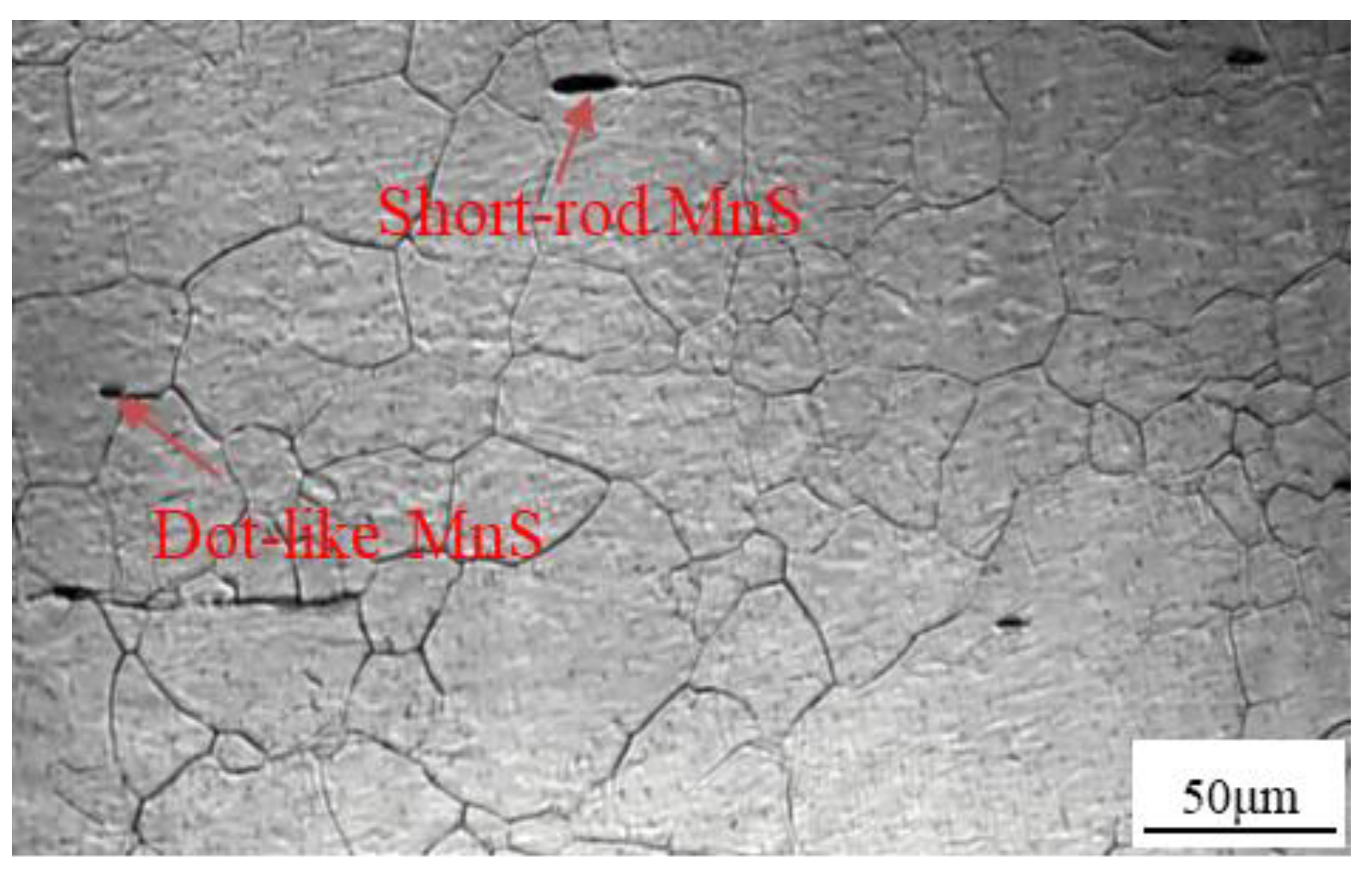
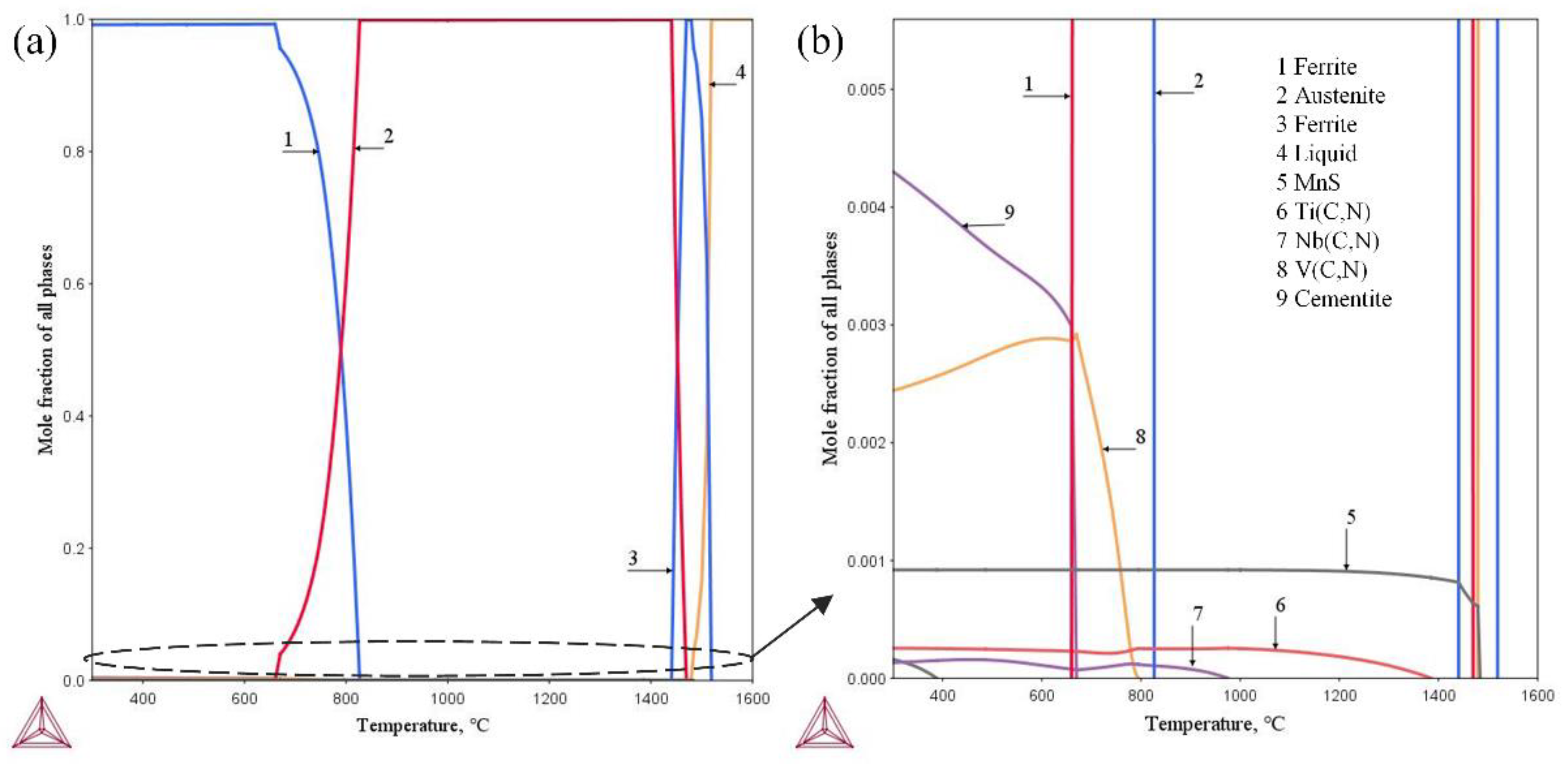
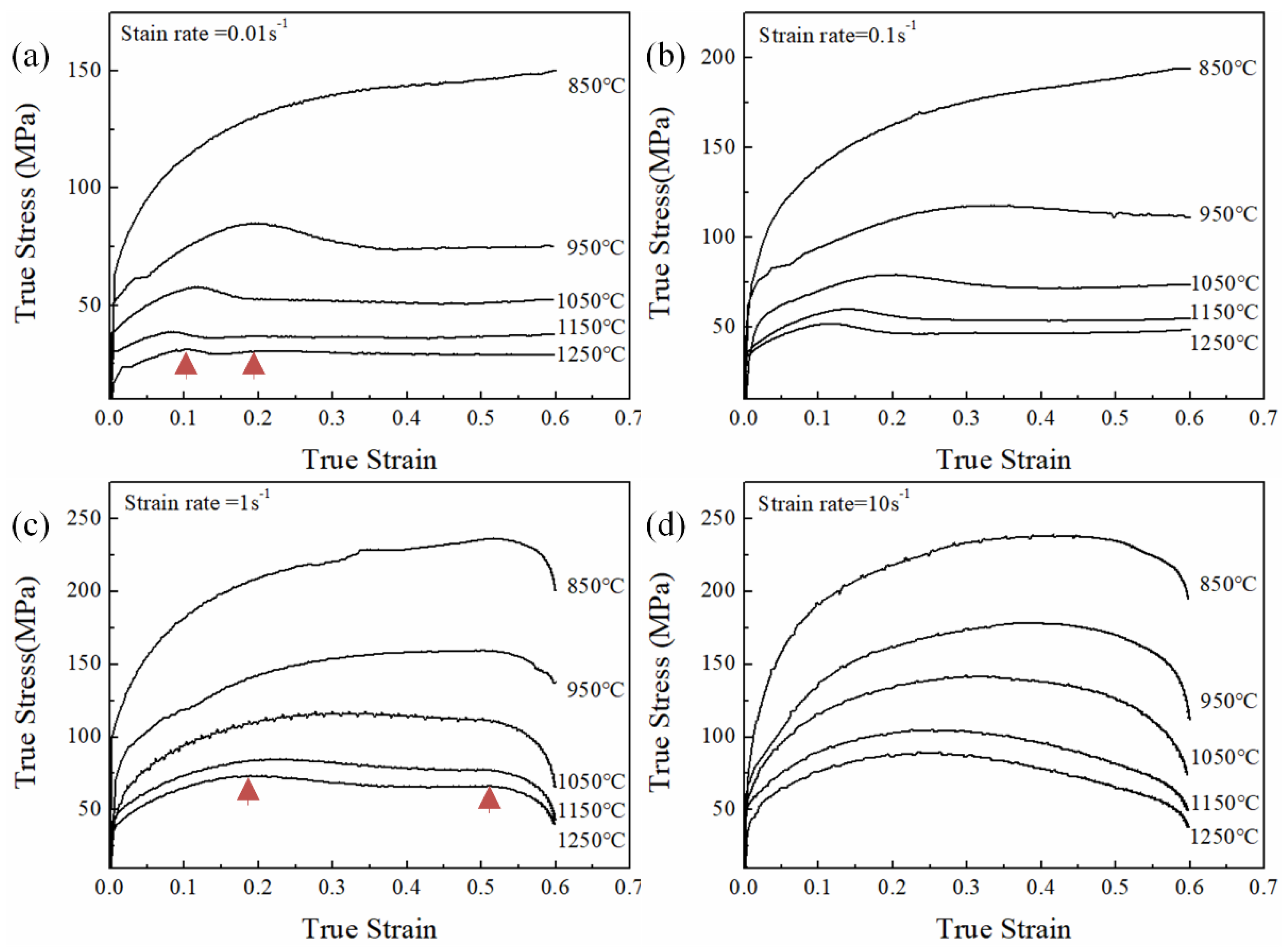
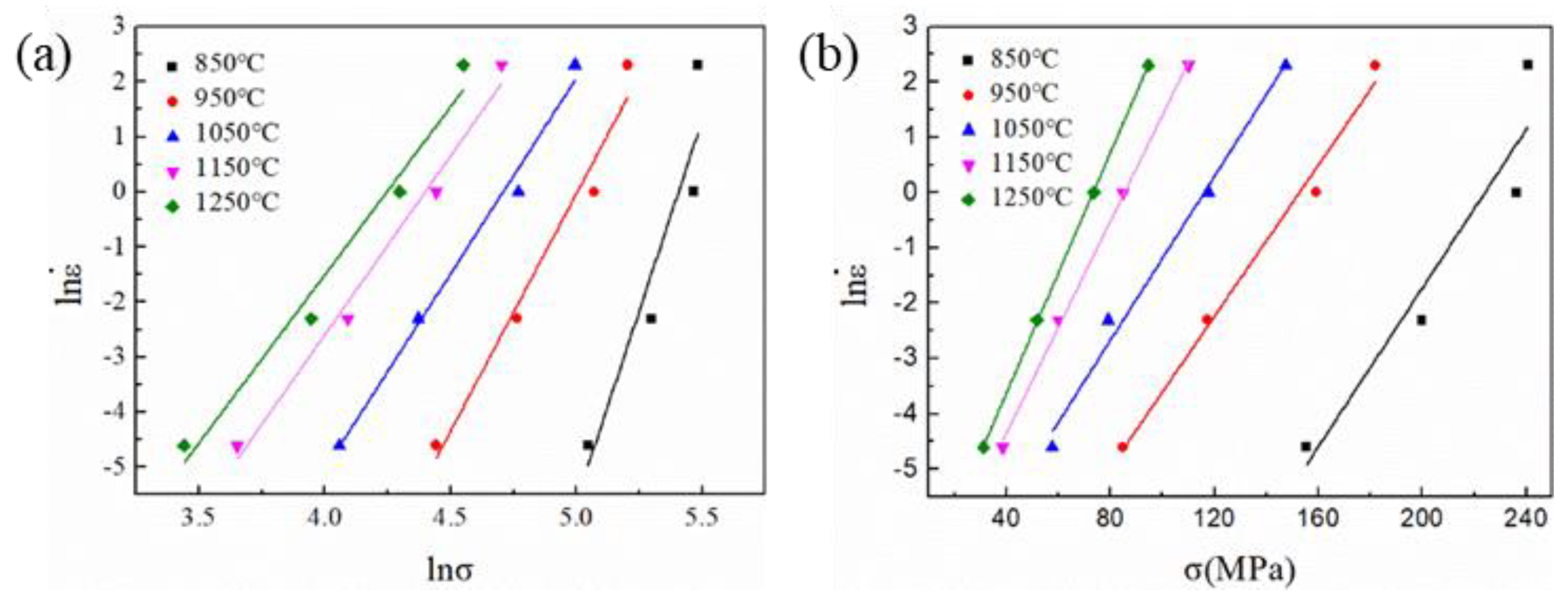
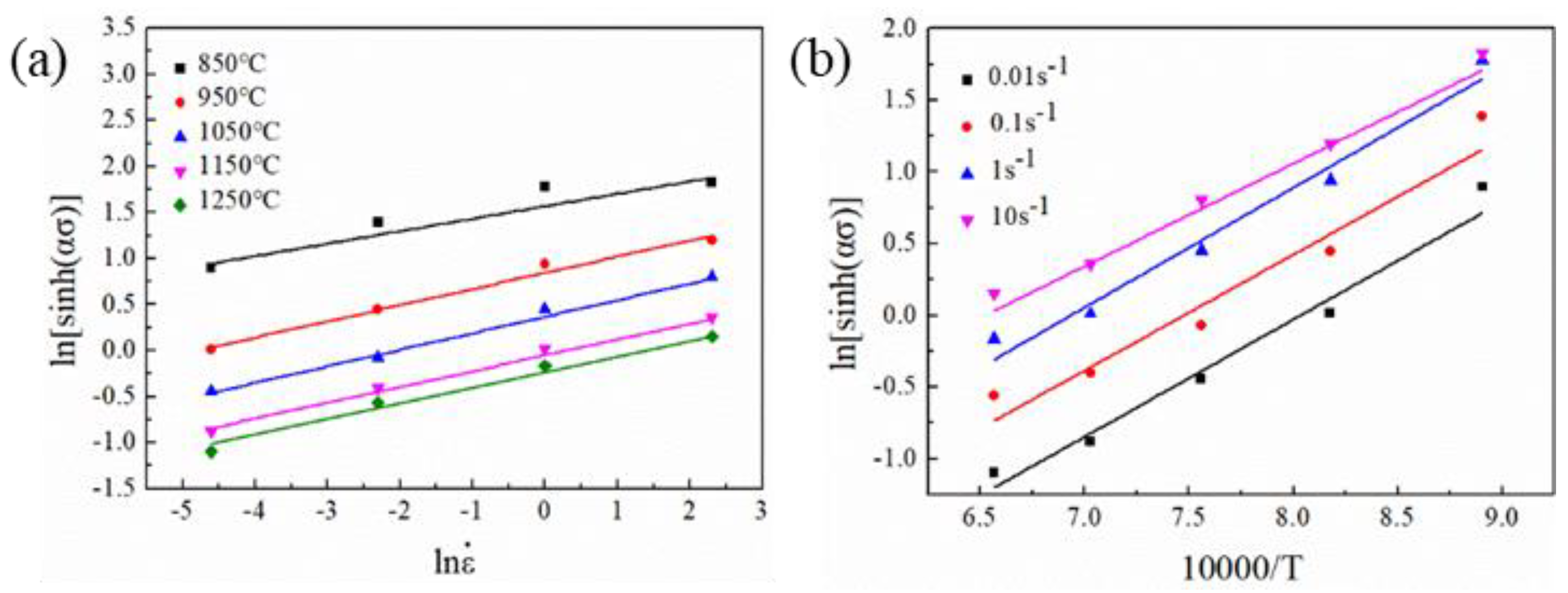




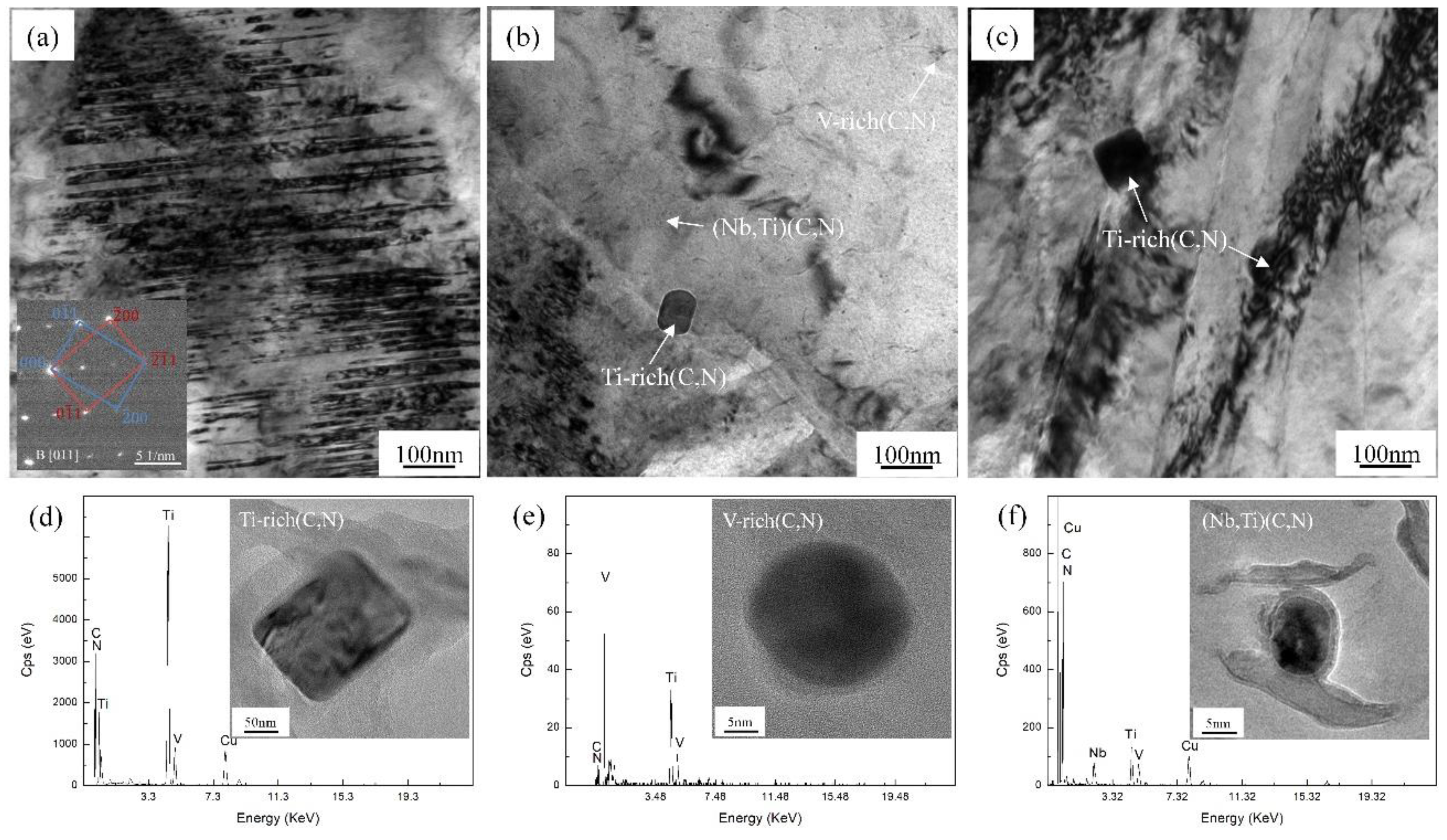
| C | Si | Mn | Cr | S | V | Nb | Ti | Fe |
|---|---|---|---|---|---|---|---|---|
| 0.25 | 0.38 | 2.01 | 0.52 | 0.046 | 0.119 | 0.005 | 0.013 | Balance |
| 850 °C | 950 °C | 1050 °C | 1150 °C | 1250 °C | |
|---|---|---|---|---|---|
| 0.01 s−1 | 112 (0.099) | 75 (0.011) | 54 (0.077) | 35 (0.043) | 27 (0.055) |
| 0.1 s−1 | 143 (0.115) | 101 (0.123) | 71 (0.109) | 50 (0.0547) | 38 (0.017) |
| 1 s−1 | 178 (0.091) | 120 (0.107) | 94 (0.100) | 70 (0.085) | 60 (0.075) |
| 10 s−1 | 187 (0.092) | 149 (0.125) | 121 (0.109) | 87 (0.087) | 77 (0.110) |
| Parameter | n1 | β | α (MPa−1) | n | b | A (s−1) | Q (kJ/mol) |
|---|---|---|---|---|---|---|---|
| Value | 8.196 | 0.086 | 0.01049 | 6.017 | 7958.28 | 1.33 × 1016 | 398.13 |
Publisher’s Note: MDPI stays neutral with regard to jurisdictional claims in published maps and institutional affiliations. |
© 2020 by the authors. Licensee MDPI, Basel, Switzerland. This article is an open access article distributed under the terms and conditions of the Creative Commons Attribution (CC BY) license (http://creativecommons.org/licenses/by/4.0/).
Share and Cite
Yang, Y.; Zhao, X.-M.; Dong, C.-Y.; Zhao, X.-Y. Influence of Hot Deformation and Precipitates on the Recrystallization of Nb-V-Ti Free-Cutting Steel. Metals 2020, 10, 1587. https://doi.org/10.3390/met10121587
Yang Y, Zhao X-M, Dong C-Y, Zhao X-Y. Influence of Hot Deformation and Precipitates on the Recrystallization of Nb-V-Ti Free-Cutting Steel. Metals. 2020; 10(12):1587. https://doi.org/10.3390/met10121587
Chicago/Turabian StyleYang, Yang, Xian-Ming Zhao, Chun-Yu Dong, and Xiao-Yu Zhao. 2020. "Influence of Hot Deformation and Precipitates on the Recrystallization of Nb-V-Ti Free-Cutting Steel" Metals 10, no. 12: 1587. https://doi.org/10.3390/met10121587





